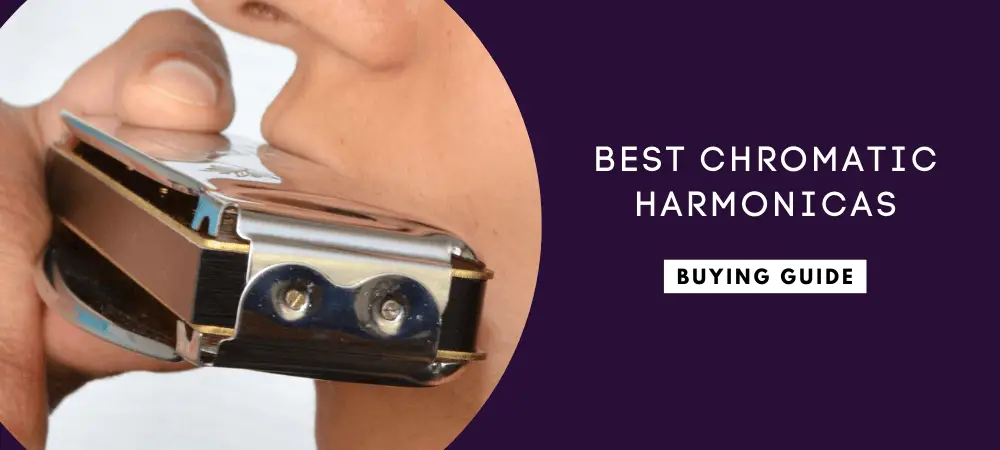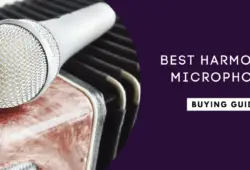Whether you can it a French harp, a mouth organ, or a harmonica, worry not, it’s all the same thing.
What you might be wondering though is, “Which one is the chromatic harmonica?”
Well, certain harmonicas come with a button-activated sliding bar that controls airflow. These are the chromatic harmonicas we shall be talking about in this article.
The chromatic harmonica has been around since 1924, and there are a ton of musical legends who are also accomplished, chromatic harmonica players.
They include Stevie Wonder, Tommy Reilly, Toots Thielemans, and Willi Burger, just to mention a few.
Its affordability, playability, and portability are some of the characteristics that make the harmonica a great instrument to learn.
Not to mention that this tiny instrument can deliver a breath-taking range of tones.
So, here’s all you need to know to get started with your first chromatic harmonica.
Table of Contents
Best Chromatic Harmonica In 2024 Reviewed
This is a 10-hole, 40-tone chromatic tuned to the Key of C.
The top-grade Phosphor bronze reeds allow for rich and full notes while the thick copper-red plates result in smooth melodic tones.
The round holes on this stainless-steel harmonica are pleasant on the lips. Not to mention that they allow for a stable, pure sound that’s crisp and clear.
Measuring 5.1” L x 1.5” W and 1” H and weighing just 5.25 oz., this harmonica is small enough to fit in your pocket.
The harmonica comes with a plastic case and a cleaning cloth.
- Heavy-duty, durable construction
- Has excellent airtightness.
- Has impressive tone and volume.
- Comfortable ergonomic design.
- Affordably priced.
- Slightly bigger than the average 10-hole chromatic.
- A few notes are not well-tuned.
This 10-hole, 40-tone mouth organ features a stainless-steel cover with a very stable structure for ultimate airtightness.
The affordable pricing of this harmonica makes it an excellent option for beginners who are just starting out on their first chromatic.
The brass reeds have a pretty decent sound, with a perfect tone, and the body has a very durable build, which speaks to the equality of the instrument.
This portable chromatic harp measures 5.1” L x 1.6” W x 1.2” H and weighs 5oz.
Included in the package are a case and a cleaning cloth.
- Durably built.
- The sound is pretty impressive.
- It has a nice heft to it.
- The round holes are a nice touch.
- It offers decent value for money.
- The slide could use some lubrication.
- Air leaks a bit.
The SAXONY chromatic comes with stainless steel reeds, so how’s that for quality!
Tuned to the key of C, this 12-hole chromatic plays very smooth and has impressively crisp tones.
Well, you wouldn’t expect anything less, from stainless steel reeds, now would you?
The slider design has been optimized for airtightness and ease of use, which has also been enhanced by the round openings on the mouthpiece.
The chrome matte cover plates allow the lips to glide easily while playing, and the aluminum comb provides great tonal response.
- It has durable stainless-steel reeds.
- It has full, crisp, clear tones.
- The slide lever works effortlessly.
- Has efficient windsavers.
- Very comfortable on the mouth.
- Lacks the mellowness of brass reeds.
- It takes some time to get used to it.
This 10-hole 40-tone chromatic comes with Phosphor bronze reeds that are responsible for the harmonica’s beautiful sound.
The clear, rich tones produced
The reeds are attached to anti-corrosion copper plates that are durable and play very stably.
The smooth round hole mouthpiece is comfortable to use and produces purer sounds, in addition to minimizing moisture absorption.
Besides the harmonica, this purchase also gets you a plastic storage case and a cleaning cloth.
- Features exquisite craftsmanship.
- Produces pure, high-volume sounds.
- It has lovely bright tones.
- Very airtight.
- Ideal for professional use.
- The slide could use some lubrication.
The construction of this harmonica comprises a stainless-steel cover, bronze reeds, a brass reed plate, and ABS plastic comb.
The Phosphor bronze reeds play great, and they are perfectly in tune.
Riveted onto the 1mm brass reed plate, these reeds produce a pleasant crisp sound, which is quite impressive considering the price of the chromatic.
The electroplated cover has excellent aesthetic appeal, not to mention that this makes the harmonica easier to play as well.
The ease of playing this instrument is further enhanced by the round holes on the mouthpiece as well as the ergonomic design that’s comfortable to hold.
- A good quality low-priced harmonica.
- Smooth design allows for crisper sounds.
- Ergonomically comfortable to play.
- It has a fantastic tone comparable to higher-end models.
- It offers great value for money.
- The case is somewhat flimsy.
This is a 16-hole, 64-reed, 4-octave chromatic harmonica that’s tuned to the key of C.
This hand-crafted instrument has been specially designed for professionals.
This fact is evident in the amount of attention paid to detail.
The ergonomically-designed 2-piece mouthpiece with rounded holes is comfortable on the lips, and the slide mechanism slides smoothly with ease.
The components of this harmonica comprise phosphor bronze reeds and an ABS plastic comb, enclosed within chrome-plated covers.
This luxurious chromatic comes with a beautiful deluxe case having soft lining for protection of your instrument.
- Hand-constructed for professional use.
- It is completely airtight.
- Delivers mellow tones and quick response.
- The slide action is quiet and smooth.
- It is re-tunable.
- The wind-save valves tend to stick in cold weather.
The Swan SW1248 is a 12-hole, 48-tone, 3-octave harmonica.
Swan has created quite a reputation for themselves, offering quality, lower-priced harmonicas for beginners. That’s just what the Swan SW1248 promises.
The first striking thing you will notice is the beautiful aesthetics of the harmonica, and it plays just as well.
It comprises phosphor bronze reeds attached to a copper reed plate, and all components are enclosed within copper chrome-plated silver covers.
The mouthpiece comes with round holes that are very comfortable on the player’s lips as they glide from one end to the other.
Ease of use of further enhanced by the precision-engineered slide
The chromatic sounds pretty good, and the full open cover design means that tones are amplified for a fuller, louder sound.
- Looks stylish.
- Open cover design amplifies sounds.
- Has galvanized parts for rust-free durability.
- An inexpensive option for beginners.
- Has windsavers.
- Leaks air.
This mouth organ by Kmise is a 10-hole, 40-tone, C-scale chromatic.
The phosphor bronze reeds in the instrument produce loud mellow sounds, which are of much better quality than what you hear when using brass reeds.
Because the reeds are CNC manufactured, this harmonica is extremely precise.
The 0.03mm gap between the reeds and reed plate allows for impressive airtightness, such that the harp plays well without sticking.
This is the kind of chromatic that will still play impressively well even without warming it up first.
The firm and stable structure of this chromatic, coupled with its exceptional workmanship, guarantee good airtightness for bright sounds.
- Built for durability using anti-rust components.
- High resilience bronze reeds allow for a quick response.
- Has good airtightness.
- Produces loud sounds.
- Easy to play.
- Has no valves/windsavers.
Tuned to the Key of C, this is a 16-hole, 64-tone harmonica with a full 4-octave range.
One little fun fact for you: introduced in 1938, the 64 Chromonica was the first chromatic that boasted of a range of over 4 octaves!
Quite impressive, don’t you agree?
This tonal range means that the harmonica can hit impressive registers found throughout the repertoire of classical music.
If you’ve been looking for a great 4-octave chromatic, then why not get the harmonica that started it all?
I can guarantee that all these years later, the 64 Chromonica is still your best bet if you’re looking for a real workhorse.
- It features traditional cover design and embossing.
- Suitable for professionals.
- It has excellent sound quality.
- The 4-octave reach can play a wide range of music.
- Comfortable to hold and play.
- The slider is a bit clunky.
This East Top harmonica is a 12-hole, 48-tone chromatic tuned to the key of C.
The brass coated cover is painted black, and this gives the harp a very eye-catching appearance, contrasted against copper-nickel plating.
The internal components comprise phosphor bronze reeds attached to brass reed plates and an ABS Resin comb.
These materials result in a very powerful and beautiful sound produced from the instrument.
Not to mention that precision in its assembly allows for exceptional airtightness.
- Very high quality but affordably priced.
- Produces a loud, beautiful sound.
- Airtight
- It has a nice heft to it.
- It comes with a 2-year guarantee.
- The slider could use some polishing.
Which Is Better Diatonic or Chromatic Harmonica?
Diatonic harmonicas have a simple, compact 10-hole design.
The design of these harmonicas is such that the player can only play in a specific key. Therefore, diatonic harmonicas are available in all 12 keys of music.
The 10 holes offer the player 19 notes that can be played in a 3-octave range.
The key-specific nature of a diatonic harmonica is why they are popularly used for Rock, Blues, Country, and Pop music.
Chromatic harmonicas come in a variety of designs that can have 8, 10, 12, 14, or 16 holes.
Working pretty much like a piano, a chromatic harmonica is designed to play every tone, and in every octave, including semi-tones.
Because you can play any key and any type of scale, chromatic harmonicas are best suited for intricate melodies such as those found in Jazz and Classical music.
Owing to their versatility and complexity, Chromatic harmonicas are often much more expensive than their diatonic counterparts.
Seeing the differences between a diatonic and a chromatic harmonica, you can see why it would be difficult to establish which of the two is better.
Both harmonicas are designed with different users in mind, to suit various styles of music.
Diatonic harmonicas sound different for over-bent notes, whereas the tonal precision on chromatic harmonicas is spot on for all notes.
Tonal quality varies as well, whereby diatonic harmonicas are very dynamic while their chromatic counterparts have minimal tonal variation.
So, which of the two is the better instrument? Well, it all depends on your approach to playing music.
Is Chromatic Harmonica Hard to Play?
When comparing the playability of a Chromatic harmonica to a Diatonic harmonica, you will realize that chromatic harmonicas are indeed harder to play.
Because this harmonica offers all natural notes as well as all sharps and flats, you require the right skill and technique to handle the sliding bar so you can play any scale and mode.
The sliding bar acts as a gear shift, that directs air either to the top or the bottom reeds so you can play all standard Western notes, without resorting to bending.
Besides mastering the art of the sliding bar, another reason why Chromatic harmonica is harder to play is that it’s harder to bend and overblow the larger reeds in this harmonica.
Despite being harder to master, learning to play a chromatic harmonica can be quite rewarding once you hear the rich-sounding chords and effects produced.
How to Choose Best Chromatic Harmonica Even For Beginners
Keys
There are 12 keys in western music (G, Ab, A, Bb, B, C, Db, D, Eb, E, F, and F#).
For beginners, it is always advisable to start with a harmonica in the key of C, before proceeding on to complex keys.
The reason why C appears to be a suitable scale is that in terms of pitch, G harmonicas are very low, whereas F# harps are very high. C harmonicas, however, are right in the middle.
This way, you’d be able to understand music theory much easier while using a C chromatic harmonica. In fact, you will find that most instruction booklets assume you are using a C harmonica.
Ultimately, the key of harmonica you need will depend on which key a song is in, and the singer often dictates this.
Keep in mind that a C chromatic harmonica can still be used to play any key on the 12-tone scale. To do so, however, you will need to learn all the appropriate scales and positions.
Number of Holes
Traditionally, chromatic harmonicas are available in 8, 10, 12, 14, and 16-hole designs.
An 8-hole chromatic has a 2-octave range of C4 to C6.
A 10-hole chromatic has a 2.5-octave range. This short harmonica is very portable.
A 12-hole chromatic comes with 3-octave ranges of 48 tones. This harmonica is available in any of the 12 keys of the Western scale, and it is relatively easy to grasp and play.
A 14-hole chromatic has a range of 3.5 octaves. This harmonica is larger than the 12-hole chromatic, and so you’d need more time for practice and familiarity.
A 16-hole chromatic has an extra octave below middle C, therefore resulting in 4 octaves. The full range of this harmonica means that you’d need a lot of practice before you’re familiar with it.
A 12-hole chromatic tuned to the key of C is often the popular choice amongst many players, including the pros. This harmonica is quite easy to play, making it an ideal choice for those starting with their first chromatic. Additionally, you’ll find that a 12-hole would be adequate for most styles of music.
A higher number of holes means that the chromatic would be able to produce a broader range of different sounds.
14- and 16-hole chromatics are larger, and they are designed to take things to the next level. These harmonicas can get into more complex ranges such as viola, violin, clarinet, trumpet, and sax.
Reeds & Reed Plates
One thing to keep in mind is that a very high or very low number of holes on a harmonica can bring about both physical and acoustic problems.
This is why a 12-hole chromatic is often considered the ideal choice for many players.
Reeds are what produce the sound/note of a harmonica, and they could be riveted, welded, or screwed in place onto the reed plate.
A 12-hole chromatic has 48 reeds, a 14-hole has 56 reeds, and a 16-hole has 64 reeds.
The reeds are usually made from hard-wearing brass. In some instances, bronze may be used as well. When used, bronze reeds will produce a brighter tone, when compared to brass reeds.
You can find stainless steel reeds on higher-priced harmonicas. Stainless steel reeds are more robust and have a longer life span than brass and bronze reeds, whereas bronze reeds are more durable than brass.
The norm is to have the reeds tuned at the time of manufacture. However, you may have instances where the reeds could be re-tuned using specialized tool kits.
One thing to keep in mind is that higher, longer reeds would be challenging to regulate, and just as well, it would be harder to get them to move.
Comb
The comb is the central and main part of a harmonica. This is where the air chambers are located, through which you blow into the instrument.
The name comes from the comb-like layout of this part of the instrument.
Different materials can be used to make the comb in a chromatic harmonica.
Wood gives rise to a pleasantly warm and mellow sound that has a natural feel. The only problem would be wood’s inherent sensitivity to water, which can cause the comb to swell and warp when wet.
However, it is worth noting that modern harmonicas now have the wood comb sealed so that it won’t expand and contract with moisture.
Metal combs can be made from aluminum or stainless steel. Although prone to corrosion, metal does not experience wear easily, and metal combs are also the most airtight. However, this is considered an expensive material for a comb.
ABS Plastic is the material that’s popularly used for a harmonica’s comb. This is because it’s easy to maintain and friendly on the lips. Over time, however, plastic can crack, and this is why higher-end chromatics make use of a Plexiglas® kind of plastic.
Cover Plates
Cover plates cover the reed plates. They are an essential consideration because they project sound, thereby determining the tonal quality of a harmonica.
These plates are available in two main types: traditional open designs and enclosed designs.
Traditional open cover designs can be made from plastic or stamped metal that’s screwed or nailed into place. Often, you will find this design in low- and mid-priced harmonicas.
Enclosed cover designs result in a louder tonal quality.
Airtightness
There needs to be a very airtight seal between the comb and reed plates. As such, reed plates which are bolted/screwed on to the comb, tend to be more efficient than those that are nailed or pinned on.
Reeds get riveted onto the reed plates, and the reed plates then get screwed onto the comb.
An airtight harmonic will be more responsive to the player, and so this way, you won’t require excessive amounts of air to enable you to play the instrument.
Windsavers
To further enhance the airtightness of the harmonica, chromatics will come with small plastic flaps covering the reed slots. These plastic flaps are called valves or windsavers.
A valved chromatic harmonica will be louder and more responsive than an un-valved chromatic.
During a draw, the one-way valves will block the airstream from entering through the blow reeds; and vice versa, during a blow.
Therefore, the player uses up less air to play a reed hence the name “windsaver.”
Ease of Use
Unlike buying a guitar or piano, buying a harmonica has the one disadvantage that you cannot try out the instrument before making a purchase.
For hygienic reasons, of course.
However, just because you cannot blow into the instrument isn’t to meant that you could not establish how easy it would be to use the harmonica.
What’s the size and weight of the harmonica? Does it have an ergonomic design? Does it feel nice in your hands?
Pay attention to the sides and edges to see whether they are smooth and easy to grab.
The slide mechanism is also essential when buying a chromatic harmonica. Is the lever easy to operate?
Check out a few reviews, including videos of the instrument in action, to see whether a particular chromatic would be pleasant on the lips.
Coming with a carry case is an added advantage for hygiene and convenience when it comes to storage and portability.
FAQs About The Best Chromatic Harmonicas
How Do You Sanitize A Chromatic Harmonica?
Sanitizing a chromatic harmonica doesn’t just apply when you’ve bought a second hand. Sanitizing is an excellent routine to do every once in a while, to ensure the harp stays healthy for you.
Ideally, you sanitize to kill or wash out anything that can breed; and this is how you ought to go about it:
Step 1: Grab the following: a new toothbrush, a clean lint-free cloth, and isopropyl (rubbing) alcohol in a spray bottle.
Step 2: Spray a light mist of isopropyl alcohol on both cover plates of the assembled harmonica then wipe clean using a lint-free cloth.
Step 3: Carefully take your chromatic harmonica apart: covers, mouthpiece, slide assembly, and reed plates.
Step 4: For each component, spray both sides with alcohol and carefully wipe clean with a cloth.
For the comb, spray with alcohol then use the new dry toothbrush to clean holes and chambers. Wipe dry.
Step 5: Once all components are completely dry, carefully reassemble the harmonica.
Inhalation of isopropyl fumes could be harmful, so do not play the harmonica before the alcohol is completely dry.
For visual guidance, perhaps this video might help:
How Long Do Harmonicas Last?
The durability of a harmonica will largely depend on how often you play, how hard you play, your musical style, and the harmonica’s construction.
A constant player, who plays very hard and loud and bends the wrong places might need to replace their harmonica after about 3 months.
With care and proper technique, an infrequent player who plays softly might even get 30 years out of their harmonica.
On average, expect a harmonica to last about 6 months before the reeds go out of tune.
How Often Should I Clean My Harmonica?
You would need to clean your harmonica after every 10-40 hours of playing or so.
Conclusion
A good quality chromatic harmonica would set you back anywhere between $120 and $250.
This is far much more than you would spend on a diatonic, but believe me, it’s worth every penny.
A chromatic allows you the freedom to play in any key, not to mention you can also play more complex musical notes.
The instrument might feel hard to play at first, but with frequent playing and a good deal of practice, you’ll be a great player in no time.














